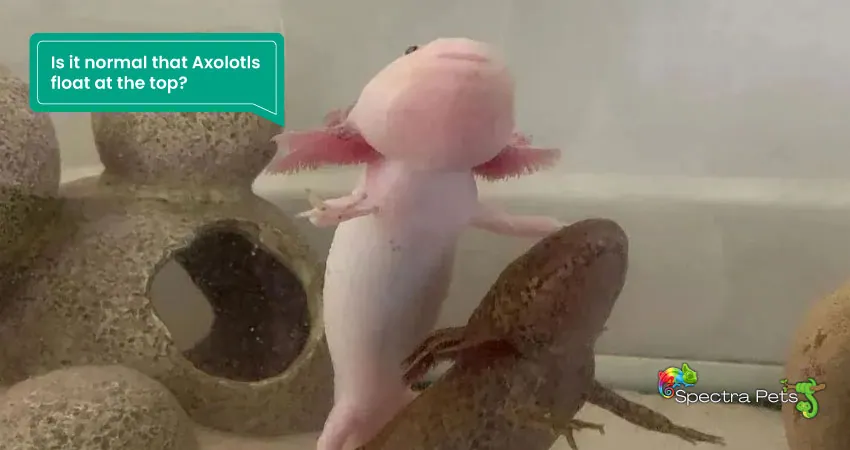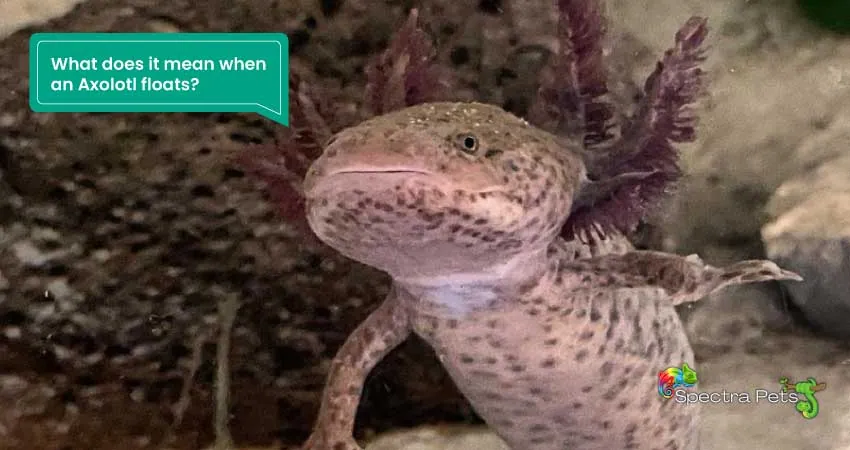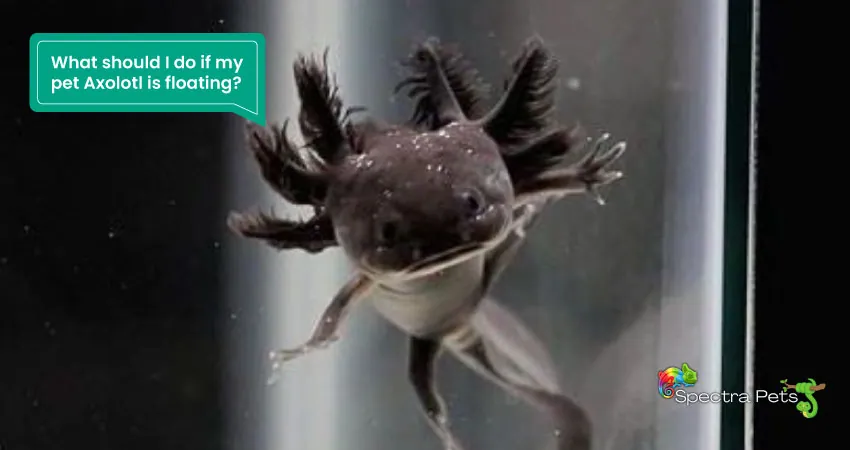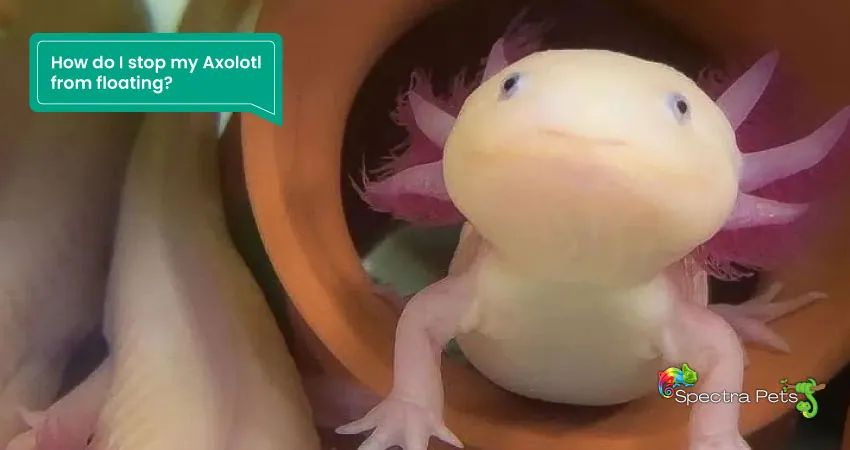The fact that a lot of aquatic creatures float on the surface of water when they die is pretty concerning for any aquatic pet owner. This is a prevalent sign of them passing away. The same is true for axolotls as well. So seeing your pet axolotl float on the water’s surface may worry you as well.
However, floating doesn’t always signify that your beloved goofy pet has met their end. There can be different reasons behind this, such as stress, bloating, injury caused by impact, indigestion, or high ammonia contents in the environment.
In this article, we’ll take a deeper look into various reasons behind your axolotl’s floating. So let’s jump into it!
Is it normal that Axolotls float at the top?

The direct answer to this is no. It is usually bad news when you see your axolotl floating, and I’ll explain why:
Axolotls prefer dark, quiet environments, so floating is not something they enjoy. They might experience stress if they float for too long, which can lead to additional health issues.
Axolotls do not float naturally. Therefore, it is an indication of something not being quite right with the axolotl itself or its surroundings. It is crucial to tend to these causes.
Wild axolotls often walk on water in order to escape from potential predators, such as birds. This is a survival instinct they have adapted to.
Judging all the aforementioned reasons, it is quite understandable that floating is a rather unusual behavior performed by these amphibians.
What does it mean when an Axolotl floats?

There are various reasons behind the axolotl’s flotation to the surface. I will describe them below:
Indigestion/Bloating
It is common for these amphibians to exhibit symptoms of digestive problems, such as gas and bloating. It can be caused by different things.
It is possible that it consumed an excessive number of food prills that were overly wet. Unbalanced or changing water temperatures may be behind this as well.
Impaction
Impaction is something you should take pretty seriously. Sometimes axolotls eat stuff that is not quite suitable for their tiny bodies, such as food that is larger than their heads, gravel, or rocks. Impaction is more common in these goofy amphibians because they will consume anything that fits in their mouth.
Additional Read: Can Axolotls Have Sand in their Tank?
High Ammonia in Water
Ammonia in the aquarium water comes from waste produced by any living being there. Therefore, if you do not clean the aquarium and filter the water regularly, ammonia will build up in the aquarium. As a result, the axolotl will swim to the surface in an attempt to escape from the aquarium.
Death
Finally, it may also be an indication that your pet friend has met its end if you see it floating. In this case, it is too late to do anything.
Signs of my Axolotl dying
There are some obvious signs that your favorite pet axolotl is nearing the end of its life:
- Floating
- Obvious health issues
- Loss of balance while swimming
- Lack of appetite
- Losing vibrancy and motion on gills
- Visible injuries and sore skin
What should I do if my pet Axolotl is floating?

Well, first, you need to verify whether your pet axolotl is still alive. The body of a dead axolotl does not float up to the surface immediately after passing. It usually takes a couple of days for the body to come to the surface.
However, if the axolotl hasn’t quite bitten the dust yet, then there are some things you need to check and adjust. I’ve mentioned them below:
Check on their Diet
It is very important to note that axolotls should not be given any food while they are suffering from bloating or impaction. It is already suffering, and in this situation, food will only increase the agony.
What you need to do in this situation is contact a professional veterinarian as soon as possible, as they will be the ones to know how to handle the situation properly.
Read More: Can Axolotls Eat Fish Food?
Cleaning the Aquarium and improving the Water Quality
If the water in your aquarium is dirty and has high contents of ammonia, you immediately need to prioritize giving the aquarium a thorough cleaning. Filtering and changing the water is also very helpful in this situation. Adjust the temperature and pH levels to those that are suitable for axolotls after changing the water. Once the axolotl is back in its preferred environment, it will eventually relax and go back to its normal behavior.
Checking/Changing the Aquarium Filter
There is always a chance that your filter may not be functioning properly. Therefore, give the filter an inspection and check if it is functioning properly. You may want to change the filter if it is not working.
Cooling the Axolotl down
Axolotls occasionally swim to the surface in response to their discomfort at higher temperatures. Bringing down the body and blood temperature helps significantly with calming down your pet axolotl.
You can easily do this by putting the animal in a small bowl filled with intensely refrigerated water. Just make sure that the water you’re using is clean and dechlorinated.
How do I stop my Axolotl from floating?

Since floating is not a natural behavior of this species, it is quite essential to prevent them from floating. There are a few preventive measures to follow, as I have listed them below:
- If your pet is floating due to gas buildup, a simple scare should be sufficient to send them back to the bottom. In order to completely prevent gas buildup, remember to soak the food prills before feeding them to your axolotls. Also, keep a track of water quality and changes in water temperature. Additionally, do not provide them with too much food.
- Impaction can lead to a critical injury and might even cause death. Since it is mostly caused by tank decorations, using very fine gravel or just plain sand aids in preventing this.
- In order to prevent high ammonia content in your aquarium from causing your axolotl to float, regularly measure the ammonia content of water and make adjustments as necessary. If the ammonia levels rise too often, you may need to change your filtration system and go for a bigger one.
- Prevent inducing stress to your pet amphibians in order to stop them from floating.
Frequently asked Questions (FAQ)
Why is my pet Axolotl swimming to the top?
There are three possible causes: the water temperature is too high, it is not getting enough oxygen from the water, or it is stressed and wants to escape.
Do Axolotls float when they sleep?
Although it is not a common behavior, some axolotls float when they sleep. Don’t mistake a floating axolotl that is fast asleep for a dead one!
Why is my pet Axolotl floating upside down?
Floating upside down is caused by excessive air buildup in its stomach. This species frequently struggles to digest the food they eat because their gut anatomy is underdeveloped.
Wrapping Up
Every axolotl has its own unique behavior pattern. However, floating is not one of them. It is important to monitor how your own pet gets around and act accordingly. You can easily resolve this problem by identifying the exact reason and following the remedy.
If none of the methods mentioned in this article come to help, you should consider visiting a veterinary professional.
This article is intended to be a guide and is by no means a replacement for professional veterinary assistance.
